Having problems reading this email? View it in your browser >>
|
||
 |
||
|
||
Contents
|
||
Barcelona woman controls HIV for over 15 years without treatment | ||
 Dr Núria Climent at AIDS 2022. | ||
|
The case report was presented to the 24th International AIDS Conference (AIDS 2022), being held in Montreal, Canada, and virtually this week. Although antiretroviral therapy can keep HIV suppressed as long as treatment continues, the virus integrates its genetic blueprint (known as a provirus) into the DNA of human cells, establishing a viral reservoir that is unreachable by antiretrovirals and usually invisible to the immune system. The handful of people thought to be truly cured of HIV received stem cell transplants for cancer treatment from donors with a rare mutation, known as CCR5-delta-32, that blocks HIV from entering immune cells. The new case involves a woman – dubbed the 'Barcelona patient' – who at age 59 was diagnosed with HIV during acute infection. People with acute infection have a smaller viral reservoir, which improves their prospects for a functional cure. At baseline, her viral load was about 70,000 and she still had a high CD4 T-cell count (about 800). The woman joined a small clinical trial testing immune-modulating therapies. She first received a standard antiretroviral regimen of lopinavir/ritonavir, tenofovir disoproxil fumarate and lamivudine for nine months plus a short course of cyclosporine A (an immunosuppressive drug). She then had a brief planned treatment interruption, during which she received granulocyte-macrophage colony-stimulating factor (an agent that promotes production of white blood cells) and interferon-alpha (a cytokine that regulates innate, or non-specific, immune activity). She then restarted antiretroviral therapy plus a short course of interleukin-2 (a cytokine that activates T-cells and natural killer cells). Eight weeks later, with a suppressed viral load, she undertook another analytical treatment interruption, but her HIV did not rebound as expected. Not only did her viral load remain undetectable, she also experienced a reduction of the viral reservoir. Hoping to shed more light on the woman’s unusual response, researchers performed a genetic analysis, finding that “she had no classical genetic factors” associated with natural viral control. They found that natural killer cells and CD8 killer T-cells played key roles in controlling HIV and the woman had higher levels of specific types of these than usually seen in untreated people with typical HIV progression. While this woman is an exceptional post-treatment controller, and her experimental regimen would not be suitable for widespread use, her case may provide clues to help researchers develop more broadly applicable strategies for long-term remission. | ||
Countries tailor PrEP services to increase uptake | ||
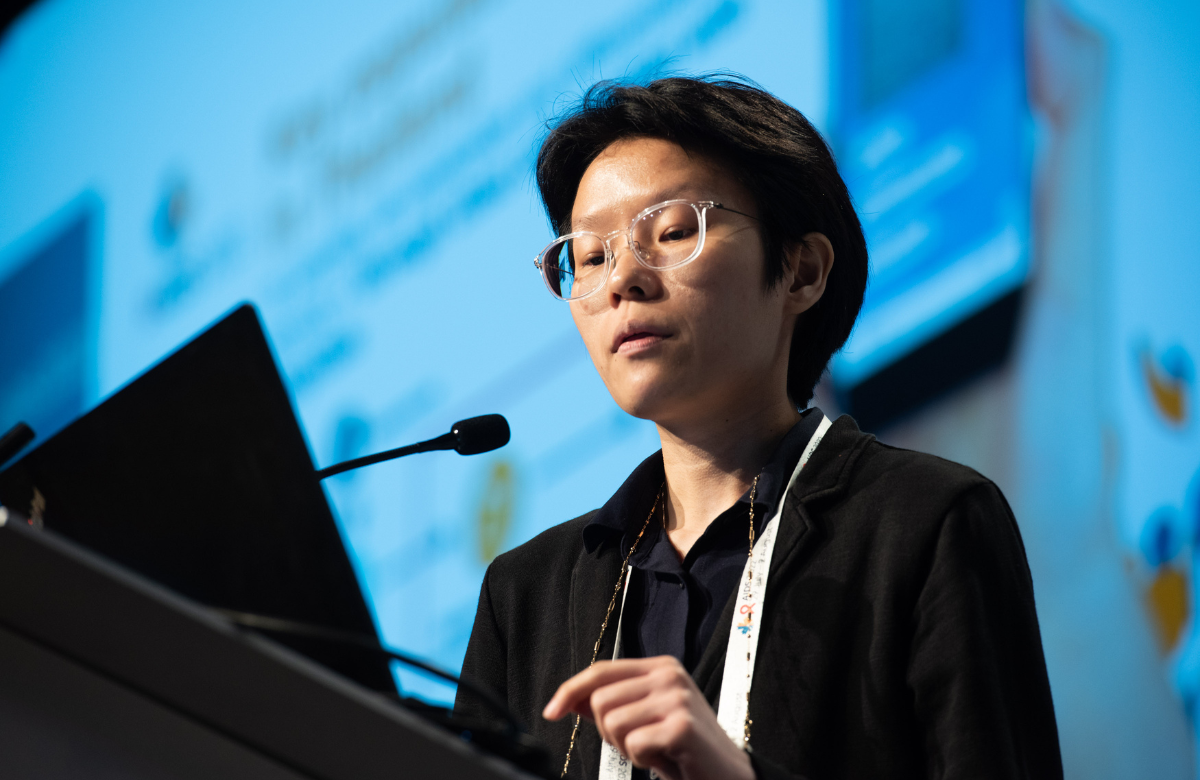 Dr Narukjaporn Thammajaruk at AIDS 2022. Photo©Marcus Rose/IAS. | ||
|
What’s known as ‘differentiated service delivery’ for PrEP has seen many countries tailoring the when (frequency of visits), who (service provider), where (location), and what (package of services), based on client preferences. Examples of successful approaches from different countries were presented to AIDS 2022. In Kenya, a model of dispensing PrEP every six months, supported by HIV self-testing, simplified PrEP delivery and halved the number of clinic visits without compromising HIV testing, retention in care, or adherence. Research from the Ministry of Health in Brazil showed that nurse-led PrEP has had an important impact on PrEP access, with a monthly growth rate of 11%. Under the previous model of care, only doctors could prescribe PrEP. Nurse-led prescriptions have significantly increased PrEP access to vulnerable populations. In the period studied, a higher percentage of nurse prescriptions were for sex workers and people who use drugs. Before nurse-led PrEP services, most of the PrEP users in Brazil were White, but this has shifted, with 63% of people taking PrEP being Black. In Vietnam, differentiating where PrEP is offered has led to increased scale-up. Clinics led by key populations play an important role – these are services led by community health workers who are men who have sex with men or transgender women. The conference heard results from one province, demonstrating the different places clients receive services. Out of 3432 clients, 32% started PrEP at public HIV clinics, 32% at key population-led clinics, 23% through telehealth, 10% at private clinics, and 2% at mobile services. In clinics led by key populations in Thailand, screening for sexually transmitted infections is provided alongside PrEP services. The conference heard about one model of care where risk assessment is carried out via an online survey, and counselling over a video or telephone call. The client only visits the clinic to take their specimen for testing. The World Health Organization launched a new technical brief at the conference, intended to support countries in developing and implementing differentiated PrEP service delivery in their programmes. | ||
Trans people left out of many countries’ strategic HIV plans | ||
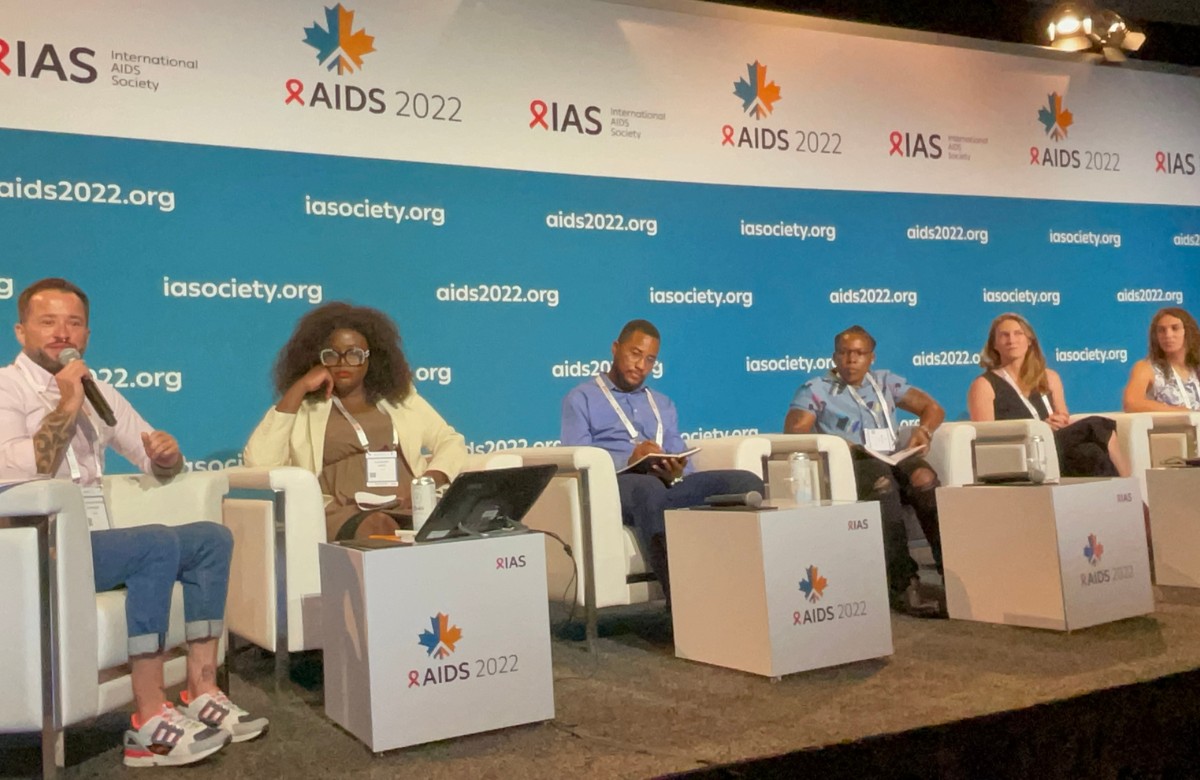 The Trans Inclusion in National HIV Policy and Planning session panel at AIDS 2022. Photo by @GATEOrg. | ||
|
In a global sample of 60 countries with high HIV prevalence, only 8% fully included trans people in all aspects of their HIV national strategic plans. Some of these countries made no mention of trans people at all, according to research presented to AIDS 2022. Trans women are 66 times more likely to be living with HIV than the general adult population, and trans men nearly seven times. Researchers analysed 60 national strategic plans for countries with the highest HIV prevalence in eastern and southern Africa (16), western and central Africa (15), Asia and the Pacific (13), Latin America and the Caribbean (9) and eastern Europe and central Asia (7). Each plan was analysed for trans inclusion across five sections: narrative, epidemiological data, monitoring and evaluation indicators and targets, activities across the HIV continuum of care, and budgets. Sixty-five per cent of the plans mentioned trans people in at least one section. However, only 8% included trans people in all five key sections. Countries such as China, Vietnam, Ethiopia and Tanzania did not include trans people at all. The authors recommend that governments should meaningfully engage with trans communities when formulating strategic plans. International funders, such as the Global Fund and PEPFAR, can provide technical assistance and funding to trans community organisations, but can also require trans inclusion in any research that they are funding. Advocates need to decide what they want to be included in their country’s strategic plan (for example, trans-specific budgetary targets for HIV prevention, or the use of peer navigators to conduct HIV testing activities) and how best to engage with government officials to ensure specific representation and inclusion. | ||
HIV test-and-treat reduces TB incidence in the community | ||
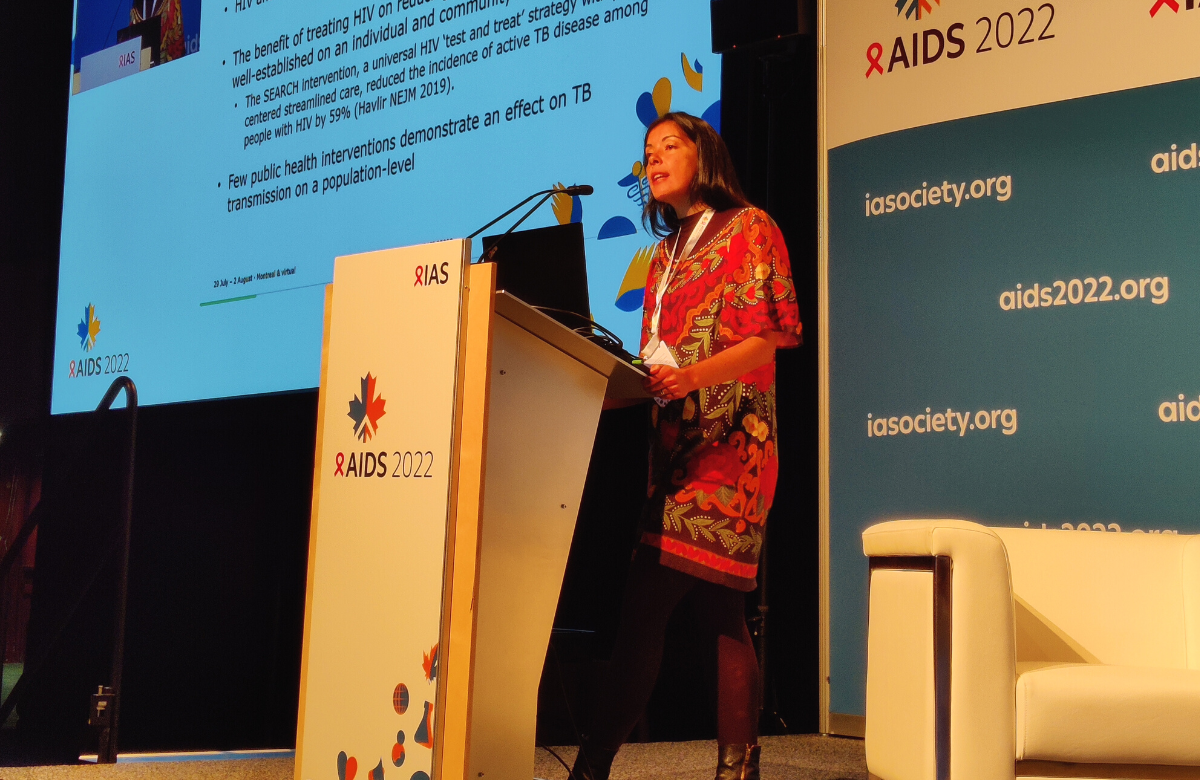 Dr Carina Marquez at AIDS 2022. Photo: Roger Pebody. | ||
|
The SEARCH study is one of the largest implementation studies of universal HIV test-and-treat to be conducted. The study randomised communities to receive either the intervention or standard of care according to national guidelines. It took place between 2013 and 2016 in rural communities in Uganda and Kenya. The intervention consisted of: a multi-disease prevention campaign that included testing for HIV, diabetes and high blood pressure, with a two-week health fair and household testing in each community; linkage to care of anyone who tested positive; and immediate antiretroviral therapy, regardless of CD4 count, for anyone testing positive for HIV. Previous results from the study have shown positive impacts, including very high rates of HIV testing and viral suppression. This analysis focused on TB incidence in nine communities in Uganda, where TB symptom screening was a component of the intervention. The researchers tested 4884 people in 1435 households at baseline, with a majority of those tested being under 18. Twenty-two per cent tested positive (indicating prior TB exposure) at baseline. One year later, 78% of those who had tested negative at baseline were available for re-testing. After one year, the incidence of TB was 27% lower in intervention communities. The reduction in risk was statistically significant in children aged 5 to 11 but not in participants aged 12 and over, probably because adolescents and adults were more likely to have been exposed to TB previously. Dr Carina Marquez said that the reduction in TB incidence is likely to have several causes, including a reduction in how long people are infectious due to improved detection and treatment of active TB through symptom screening. In addition, progression to active TB is likely to be reduced due to improved immune status in people on antiretroviral treatment. This leads to a reduction in the number of people with active TB in the community. | ||
Minimal antibody response in trial means change of course for HIV vaccine research | ||
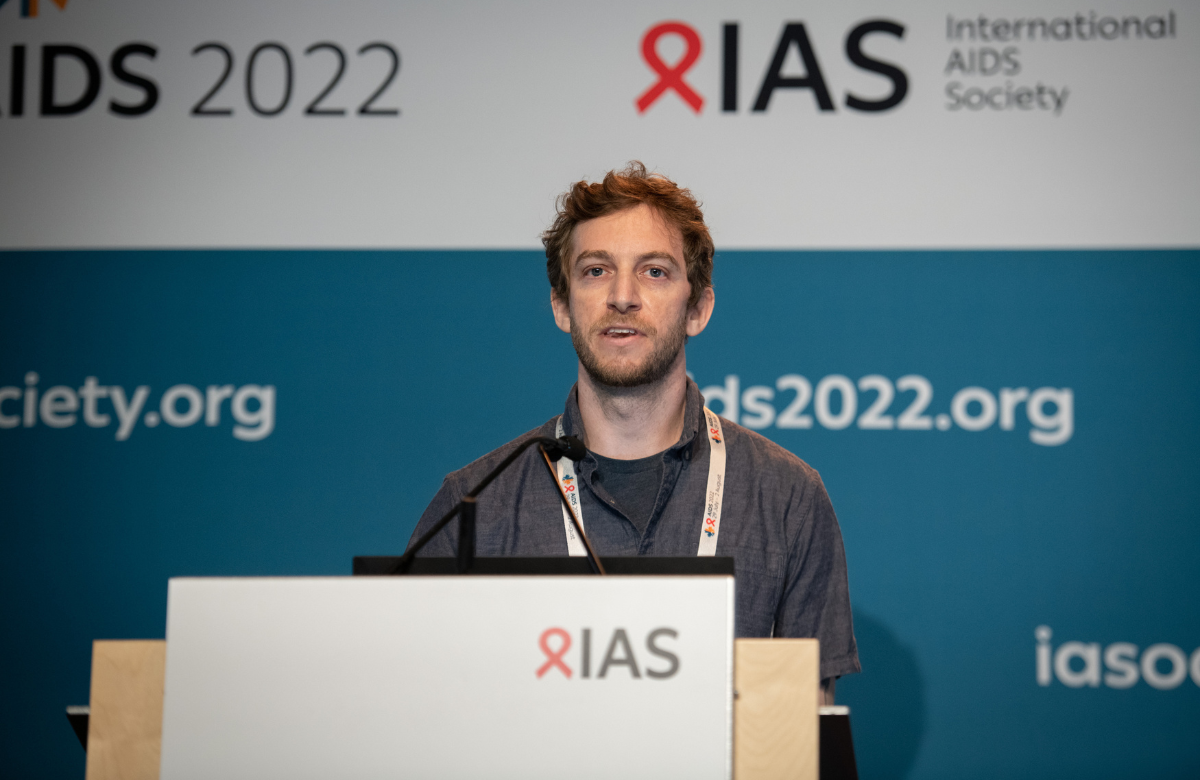 Dr Avi Kenny at AIDS 2022. Photo ©Steve Forrest/Workers’ Photos/IAS. | ||
|
Unfortunately, no efficacy trial has produced a result even as positive as the 31% reduction in infections seen in the RV144 trial, 13 years ago. The Imbokodo trial recruited 2600 young women in five southern African countries. There were 14% fewer infections in the women given the vaccine than in women given a placebo, but this did not reach statistical significance (in other words, it could have been chance). Researchers looked at 270 participants who stayed HIV negative and compared them with 54 participants who acquired HIV. They found a single correlate of risk. Women with antibodies that reacted more strongly to two specific parts of the HIV envelope protein (called the V1 and V2 loops) were about 30% less likely to become infected. The analysis tells us that the vaccines we have generate a degree of immunity to HIV; but in the large majority of people, that response is too weak, and above all too specific, to translate into useful efficacy. HIV vaccine researchers at the conference discussed current and planned work in a new direction – using messenger RNA (mRNA) technology to create HIV vaccines. Several trials have started in the last few months using experimental mRNA vaccines. | ||
Widespread PrEP use is not leading to more hepatitis C | ||
 Lopolo/Shutterstock.com. Image is for illustrative purposes only. | ||
|
Hepatitis C prevalence rose among gay and bisexual men with HIV during the decade before direct-acting antiviral treatment for hepatitis C became widely available. Hepatitis C appeared to spread in sexual networks where unprotected anal intercourse took place predominantly between men living with HIV. There have been concerns that increased use of PrEP and a reduction in condom use among gay and bisexual men could lead to an increased incidence of hepatitis C in HIV-negative gay and bisexual men, as a result of more condomless sex between men with differing HIV statuses. Researchers in Melbourne carried out a systematic review and meta-analysis to investigate the incidence of hepatitis C during PrEP use in cohorts of gay and bisexual men, as well as the prevalence of hepatitis C in men starting PrEP. The researchers identified 18 studies published between 2015 and 2022 conducted in Australia, North America and Europe. Hepatitis C incidence was higher in studies that began before broad access to direct-acting antivirals. The study authors say antiviral treatment is likely to have reduced transmission in gay and bisexual men’s sexual networks. | ||
Scientific analysis from Clinical Care Options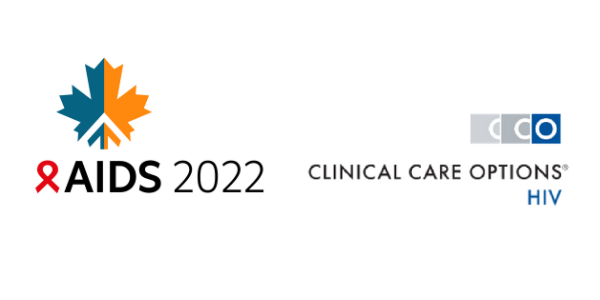
Engage in the scientific analysis of data presented at AIDS 2022 with rapid post-conference webinars by expert faculty, capsule summaries, on-demand webinars, slides and ClinicalThought commentaries provided by Clinical Care Options. Key HIV Studies Influencing My Practice Following AIDS 2022 On 3 and 4 August, join Dr David A. Wohl or Professor Chloe Orkin in a live, interactive webinar as they provide a rapid update of HIV treatment and prevention data from AIDS 2022 and answer your questions. | ||
Connect with us |
||
Official conference partners |
||
|
NAM's news coverage of AIDS 2022 has been made possible thanks to support from Gilead Sciences Ltd and ViiV Healthcare. |
||
|
aidsmap is an award-winning, community-based organisation, which works from the UK. We deliver reliable and accurate HIV information across the world to HIV-positive people and to the professionals who treat, support and care for them.
NAM Publications
Cally Yard, 439 Caledonian Road, London N7 9BG Company limited by guarantee. Registered in England & Wales, number: 2707596 Registered charity, number: 1011220 To unsubscribe please click here Privacy Policy: www.aidsmap.com/about-us/confidentiality |